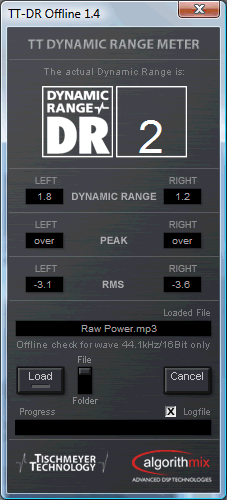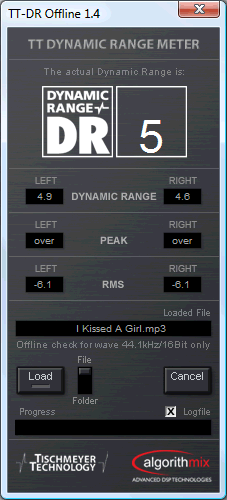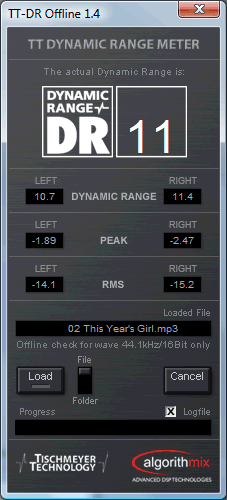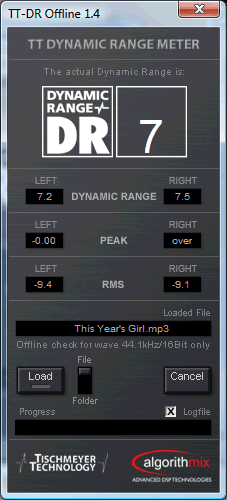A new development in the loudness wars backlash: a downloadable application to measure the dynamic range of your music.
Audiophiles have been complaining for years about the tendency of modern CD and download mastering to maximize the loudness of the music at the expense of the dynamic range. This type of compression squashes the peaks and amplifies the quieter parts to achieve a more even sound. This is encoded at a high volume level so that the music sounds as loud as possible. The idea is to make the music stand out more. Unfortunately the music also sounds less natural and loses the contrast between louder and quieter passages, making it more fatiguing and generally less interesting.
Once established though, this practice is hard to reverse, since new releases that have full dynamic range will sound quieter than average, which the industry considers risky.
Even the forthcoming Beatles remasters will be mastered to some extent for loudness. This is the careful but self-contradictory wording from the press release:
Finally, as is common with today’s music, overall limiting – to increase the volume level of the CD – has been used, but on the stereo versions only. However, it was unanimously agreed that because of the importance of The Beatles’ music, limiting would be used moderately, so as to retain the original dynamics of the recordings.
The latest counter-initiative is from German mastering engineer Friedemann Tischmeyer, who has set up the Pleasurize Music Foundation with the aim of establishing industry standards for loudness and dynamic range. Windows users can download a utility to measure the dynamic range of a WAV or MP3 file, the TT Dynamic Range Meter (a Mac version is in preparation). Higher numbers are better, and the Foundation intends to set 14 as the minimum standard, which to judge by my own measurements seems ambitious; even releases from well before the loudness wars do not meet it.
I did a few measurements. Here is one of the loudest releases of all time, Iggy Pop’s Raw Power remaster (score 2, ouch):

Here’s Katy Perry, I kissed a girl – a typical modern release (score 5):

Here’s a couple showing a progression. The track is This Year’s Girl, from This Year’s Model by Elvis Costello and the Attractions. Here is an early CD from the eighties (score 11):

and here’s the most recent Deluxe Remaster (score 7):

showing how remasters tend to boost volume and diminish dynamic range. But can anyone beat Iggy Pop?
Which begs the question. Can you have too much dynamic range if older releases would struggle to reach a 14 rating?
Surely if cranking up the loudness spoils the natural feeling, deliberately tweaking to get a 14 rating could also have a less pleasing sound than settling for a 10. Wouldn’t aiming for a specific mark be just as bad as loudness, as you should be mixing to make it sound nice not pass a benchmark.
Like most other benchmarks, purely saying something is good or bad based on the result is unlikely to be accurate to what actually sounds nice. The only thing we know for sure is that the really low numbers WILL sound worse. However there must be a cutoff where artistic license / the skill of the mixing become more important.
@Alex sure, artificially manipulating an existing recording to boost the dynamic range would make it sound worse. Some pop recordings have limited dynamic range anyway.
I guess the 14 benchmark is really aimed at new recordings.
Tim
I still think you are right that 14 might be a bit optimistic. Surely songs that are deliberately meant to be noisy are always likely to be in single digits? Or am I totally misunderstanding how dynamic range works?